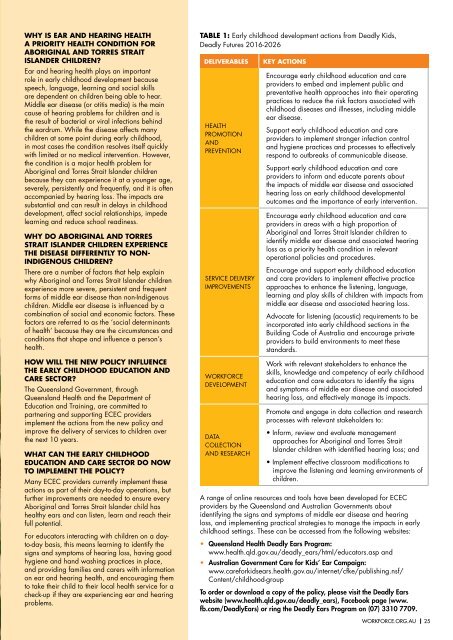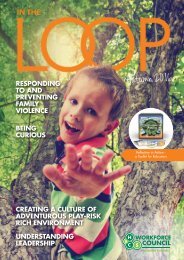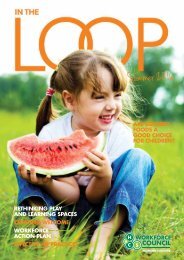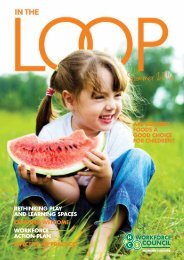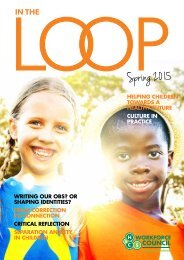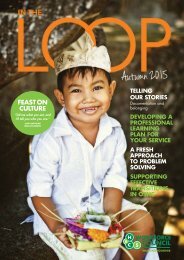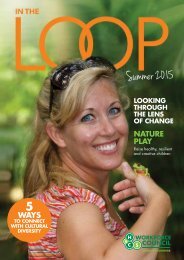In the Loop Winter 2016
Create successful ePaper yourself
Turn your PDF publications into a flip-book with our unique Google optimized e-Paper software.
WHY IS EAR AND HEARING HEALTH<br />
A PRIORITY HEALTH CONDITION FOR<br />
ABORIGINAL AND TORRES STRAIT<br />
ISLANDER CHILDREN?<br />
Ear and hearing health plays an important<br />
role in early childhood development because<br />
speech, language, learning and social skills<br />
are dependent on children being able to hear.<br />
Middle ear disease (or otitis media) is <strong>the</strong> main<br />
cause of hearing problems for children and is<br />
<strong>the</strong> result of bacterial or viral infections behind<br />
<strong>the</strong> eardrum. While <strong>the</strong> disease affects many<br />
children at some point during early childhood,<br />
in most cases <strong>the</strong> condition resolves itself quickly<br />
with limited or no medical intervention. However,<br />
<strong>the</strong> condition is a major health problem for<br />
Aboriginal and Torres Strait Islander children<br />
because <strong>the</strong>y can experience it at a younger age,<br />
severely, persistently and frequently, and it is often<br />
accompanied by hearing loss. The impacts are<br />
substantial and can result in delays in childhood<br />
development, affect social relationships, impede<br />
learning and reduce school readiness.<br />
WHY DO ABORIGINAL AND TORRES<br />
STRAIT ISLANDER CHILDREN EXPERIENCE<br />
THE DISEASE DIFFERENTLY TO NON-<br />
INDIGENOUS CHILDREN?<br />
There are a number of factors that help explain<br />
why Aboriginal and Torres Strait Islander children<br />
experience more severe, persistent and frequent<br />
forms of middle ear disease than non-<strong>In</strong>digenous<br />
children. Middle ear disease is influenced by a<br />
combination of social and economic factors. These<br />
factors are referred to as <strong>the</strong> ‘social determinants<br />
of health’ because <strong>the</strong>y are <strong>the</strong> circumstances and<br />
conditions that shape and influence a person’s<br />
health.<br />
HOW WILL THE NEW POLICY INFLUENCE<br />
THE EARLY CHILDHOOD EDUCATION AND<br />
CARE SECTOR?<br />
The Queensland Government, through<br />
Queensland Health and <strong>the</strong> Department of<br />
Education and Training, are committed to<br />
partnering and supporting ECEC providers<br />
implement <strong>the</strong> actions from <strong>the</strong> new policy and<br />
improve <strong>the</strong> delivery of services to children over<br />
<strong>the</strong> next 10 years.<br />
WHAT CAN THE EARLY CHILDHOOD<br />
EDUCATION AND CARE SECTOR DO NOW<br />
TO IMPLEMENT THE POLICY?<br />
Many ECEC providers currently implement <strong>the</strong>se<br />
actions as part of <strong>the</strong>ir day-to-day operations, but<br />
fur<strong>the</strong>r improvements are needed to ensure every<br />
Aboriginal and Torres Strait Islander child has<br />
healthy ears and can listen, learn and reach <strong>the</strong>ir<br />
full potential.<br />
For educators interacting with children on a dayto-day<br />
basis, this means learning to identify <strong>the</strong><br />
signs and symptoms of hearing loss, having good<br />
hygiene and hand washing practices in place,<br />
and providing families and carers with information<br />
on ear and hearing health, and encouraging <strong>the</strong>m<br />
to take <strong>the</strong>ir child to <strong>the</strong>ir local health service for a<br />
check-up if <strong>the</strong>y are experiencing ear and hearing<br />
problems.<br />
TABLE 1: Early childhood development actions from Deadly Kids,<br />
Deadly Futures <strong>2016</strong>-2026<br />
DELIVERABLES<br />
HEALTH<br />
PROMOTION<br />
AND<br />
PREVENTION<br />
SERVICE DELIVERY<br />
IMPROVEMENTS<br />
WORKFORCE<br />
DEVELOPMENT<br />
DATA<br />
COLLECTION<br />
AND RESEARCH<br />
KEY ACTIONS<br />
Encourage early childhood education and care<br />
providers to embed and implement public and<br />
preventative health approaches into <strong>the</strong>ir operating<br />
practices to reduce <strong>the</strong> risk factors associated with<br />
childhood diseases and illnesses, including middle<br />
ear disease.<br />
Support early childhood education and care<br />
providers to implement stronger infection control<br />
and hygiene practices and processes to effectively<br />
respond to outbreaks of communicable disease.<br />
Support early childhood education and care<br />
providers to inform and educate parents about<br />
<strong>the</strong> impacts of middle ear disease and associated<br />
hearing loss on early childhood developmental<br />
outcomes and <strong>the</strong> importance of early intervention.<br />
Encourage early childhood education and care<br />
providers in areas with a high proportion of<br />
Aboriginal and Torres Strait Islander children to<br />
identify middle ear disease and associated hearing<br />
loss as a priority health condition in relevant<br />
operational policies and procedures.<br />
Encourage and support early childhood education<br />
and care providers to implement effective practice<br />
approaches to enhance <strong>the</strong> listening, language,<br />
learning and play skills of children with impacts from<br />
middle ear disease and associated hearing loss.<br />
Advocate for listening (acoustic) requirements to be<br />
incorporated into early childhood sections in <strong>the</strong><br />
Building Code of Australia and encourage private<br />
providers to build environments to meet <strong>the</strong>se<br />
standards.<br />
Work with relevant stakeholders to enhance <strong>the</strong><br />
skills, knowledge and competency of early childhood<br />
education and care educators to identify <strong>the</strong> signs<br />
and symptoms of middle ear disease and associated<br />
hearing loss, and effectively manage its impacts.<br />
Promote and engage in data collection and research<br />
processes with relevant stakeholders to:<br />
• <strong>In</strong>form, review and evaluate management<br />
approaches for Aboriginal and Torres Strait<br />
Islander children with identified hearing loss; and<br />
• Implement effective classroom modifications to<br />
improve <strong>the</strong> listening and learning environments of<br />
children.<br />
A range of online resources and tools have been developed for ECEC<br />
providers by <strong>the</strong> Queensland and Australian Governments about<br />
identifying <strong>the</strong> signs and symptoms of middle ear disease and hearing<br />
loss, and implementing practical strategies to manage <strong>the</strong> impacts in early<br />
childhood settings. These can be accessed from <strong>the</strong> following websites:<br />
• Queensland Health Deadly Ears Program:<br />
www.health.qld.gov.au/deadly_ears/html/educators.asp and<br />
• Australian Government Care for Kids’ Ear Campaign:<br />
www.careforkidsears.health.gov.au/internet/cfke/publishing.nsf/<br />
Content/childhood-group<br />
To order or download a copy of <strong>the</strong> policy, please visit <strong>the</strong> Deadly Ears<br />
website (www.health.qld.gov.au/deadly_ears), Facebook page (www.<br />
fb.com/DeadlyEars) or ring <strong>the</strong> Deadly Ears Program on (07) 3310 7709.<br />
WORKFORCE.ORG.AU 25


